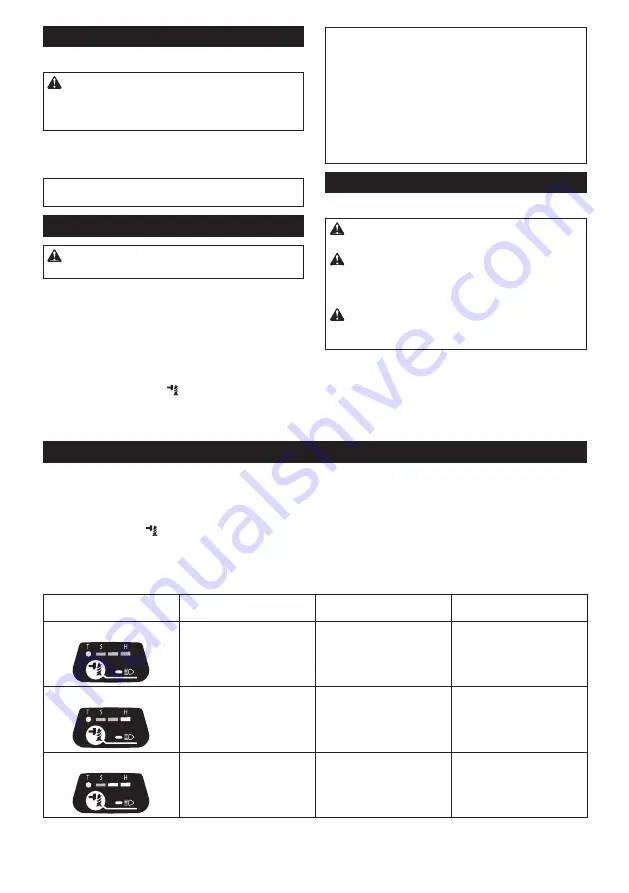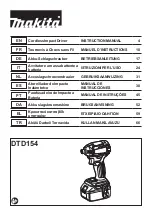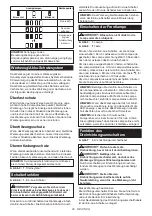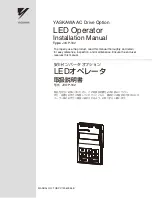
7 ENGLISH
Switch action
►
Fig.4:
1.
Switch trigger
CAUTION:
Before installing the battery car-
tridge into the tool, always check to see that the
switch trigger actuates properly and returns to
the "OFF" position when released.
To start the tool, simply pull the switch trigger. Tool
speed is increased by increasing pressure on the switch
trigger. Release the switch trigger to stop.
NOTE:
The tool automatically stops if you keep pull
-
ing the switch trigger for about 6 minutes.
Lighting up the front lamp
CAUTION:
Do not look in the light or see the
source of light directly.
►
Fig.5:
1.
Lamp
►
Fig.6:
1.
Button
Pull the switch trigger to turn on the lamp. To turn off,
release it. The lamp goes out approximately 10 seconds
after releasing the switch trigger.
To keep the lamp off, turn off the lamp status. To turn off
the lamp status, first pull and release the switch trigger.
And then press the button
for one second within 10
seconds.
To turn on the lamp status again, press the button again
similarly.
NOTE:
To confirm the lamp status, pull the trigger.
When the lamp lights up by pulling the switch trigger,
the lamp status is ON. When the lamp does not come
on, the lamp status is OFF.
NOTE:
When the tool is overheated, the light flashes
for one minute, and then the LED display goes off. In
this case, cool down the tool before operating again.
NOTE:
Use a dry cloth to wipe the dirt off the lens of
the lamp. Be careful not to scratch the lens of lamp, or
it may lower the illumination.
Reversing switch action
►
Fig.7:
1.
Reversing switch lever
CAUTION:
Always check the direction of
rotation before operation.
CAUTION:
Use the reversing switch only after
the tool comes to a complete stop.
Changing the
direction of rotation before the tool stops may dam
-
age the tool.
CAUTION:
When not operating the tool,
always set the reversing switch lever to the neu-
tral position.
This tool has a reversing switch to change the direction
of rotation. Depress the reversing switch lever from the
A side for clockwise rotation or from the B side for coun-
terclockwise rotation.
When the reversing switch lever is in the neutral posi-
tion, the switch trigger cannot be pulled.
Changing the impact force
►
Fig.8:
1.
Changed in four steps
2.
Hard
3.
Medium
4.
Soft
5.
T mode
6.
Button
You can change the impact force in four steps: hard, medium, soft, and T mode.
This allows a tightening suitable to the work.
Every time the button
is pressed, the number of blows changes in four steps.
“T” is a special mode for fastening self drilling screws. In this mode, the tool starts to drive a screw with faster rota-
tion, which is suited for drilling with the self-drilling-screw tip. Once the tool starts to tighten the screw, it impacts in
medium force grade.
For approximately one minute after releasing the switch trigger, the impact force can be changed.
Impact force grade displayed
on panel
Maximum blows
Purpose
Example of application
Hard
3,800 min
-1
(/min)
Tightening when force and
speed are desired.
Tightening underwork mate-
rials, tightening long screws,
tightening bolts.
Medium
2,600 min
-1
(/min)
Tightening when a good finish
-
ing is needed.
Tightening finishing boards,
plaster boards.
Soft
1,100 min
-1
(/min)
Tightening with less force to
avoid screw thread breakage.
Tightening sash screws, tight-
ening small screws such as M6.






































